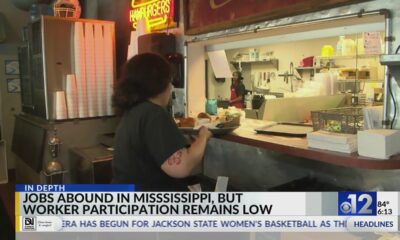Kaiser Health News
Got Milk in School? Farmers Fight Health Advocates Over the Creamy ‘Whole’ Variety
by Phil Galewitz, KFF Health News
Thu, 13 Jul 2023 09:00:00 +0000
Amanda Condo works at her family's Pennsylvania dairy farm, but her son often won't drink milk at school. He doesn't like the flavor.
That's because the cafeteria at his elementary school serves only skim milk and 1%, which he contends tastes too watered-down, she said. “It's a bad experience for kids who are our future milk drinkers, and it's leaving a bad taste in their mouths.”
Blame Congress for the absence of full-bodied, creamy whole milk from school cafeterias. In 2010, lawmakers revamped the National School Lunch Program, which led to a whole-milk ban for participating schools two years later. The goal was to reduce childhood obesity.
Now, lobbyists for the milk industry are pushing to bring it back. And their campaign is supported by a bipartisan House effort and a growing number of studies that call into question long-held beliefs about the negative health effects of whole milk.
The dairy industry is also trying to stave off a Department of Agriculture proposal to ban in middle and elementary schools the type of milk that kids like best: flavored milk, often chocolate, be it low-fat or skim.
America's milk producers worry about the type of milk schools serve, amid a decades-long decline in milk sales. New competition from oat, soy, and almond milk is taking an increasing share of the beverage market from cow's milk.
In June, the Republican-controlled House Committee on Education & the Workforce advanced a bill that would restore the ability of schools in the program to serve whole and 2% milk, an override of USDA guidelines. The bill's lead sponsor, Rep. Glenn “GT” Thompson (R-Pa.), who chairs the powerful House Agriculture Committee, considers milk a top issue, and not just because Pennsylvania is a leading dairy producer.
Thompson's bill would bypass a USDA and Department of Health and Human Services advisory committee made up of health experts that determines U.S. dietary guidelines, which in turn determine what schools serve.
Thompson and the milk lobby are concerned about milk consumption in school because if kids don't like the taste of lower-fat milk offered in the cafeteria, they are less likely to ask their parents to buy milk or to buy it themselves when they become adults. Instead of milk, they may drink soda and other high-sugar drinks, Thompson said.
Schools, which buy about 8% of milk, have not served whole milk for over a decade, yet the 3.25% fat milk is still the most common type of milk sold in the United States. Americans still buy about four times as much whole and 2% milk as they do skim and 1%, according to National Milk Producers Federation data from IRI, a market data firm.
Health advocacy organizations such as the American Heart Association and the Center for Science in the Public Interest oppose the bill, arguing that whole milk is bad for children's health and that decisions on the foods and drinks schools serve should be made by health experts, not Congress.
A growing number of studies published in recent years challenge the decades-long belief that whole milk contributes to childhood obesity. Much of that research was funded by the dairy industry.
Yet, a top researcher not funded by the dairy industry says his studies and those by others prove whole milk is not as bad for health as once thought and might even be healthier than lower-fat kinds of milk.
“The research is quite consistent: There is very little evidence that whole-fat dairy is worse for your health than reduced-fat dairy, and there is some evidence it may be better,” said Dariush Mozaffarian, a cardiologist and nutrition professor at Tufts University in Massachusetts.
He pointed to a 2020 study published in The American Journal of Clinical Nutrition that analyzed 28 other studies that compared children who drank whole milk with those who drank milk with 2% fat or less. That analysis found that, in 18 of the studies, higher milk-fat consumption was associated with lower child obesity, while 10 studies found no association with obesity levels. Combining the data from these studies, the researchers found the risk for being overweight or obese was reduced 40% among the kids who drank whole milk, and the risk for obesity declined as whole milk consumption increased.
The idea that whole milk can be as good for health as skim or low-fat milk may sound counterintuitive, said Mozaffarian. He said that when people skip fat, “what happens in the real world is people compensate for the change and increase their starch and sugar intake.” Another benefit of whole milk: The saturated fat in dairy foods is not the same as the fat in meat and other foods, he said.
But other health experts disagree, and there appears to be little consensus on the health risks of whole milk.
The Center for Science in the Public Interest said congressional efforts to restore whole milk in school put “Big Dairy” over children's health. “Congress should not be reversing this hard-fought win by making school meals less healthy by allowing whole milk,” said Meghan Maroney, a campaign manager with the food safety and nutrition-labeling advocacy group.
Eduardo Sanchez, the American Heart Association's chief medical officer for prevention, said the preponderance of the scientific data shows whole milk is worse than low-fat milk at reducing the risk of heart problems and obesity.
The association supports a USDA proposal to ban flavored milk in elementary and middle schools.
Mozaffarian agrees that flavored milk should be banned because of the higher sugar content. He doesn't buy the argument that chocolate milk is better for kids than no milk at all. “Adding sugar to milk is not a way to make it healthy for kids,” he said. “If you are worried about getting kids to drink more milk, bring back whole.” Chocolate milk contains as much as 24 grams of added sugar in a serving of 250 grams, or 1 cup — about half the sugar in the same amount of Sprite. The USDA is recommending cutting that to 10 grams.
Amy Reed, a spokesperson for the Academy of Nutrition and Dietetics, an advocacy group for dietitians, finds a middle ground among the conflicting opinions. For most children, she said, low-fat milk is their healthiest option, but drinking whole milk is acceptable “as long as they do not eat excess saturated fat in other ways and it is included as part of an overall healthy dietary pattern.”
The academy favors the USDA keeping flavored fat-free and low-fat milk in all schools, saying eliminating those options would lead to a decline in milk consumption. It says the decision to bring whole milk back to schools should be guided by national dietary guidelines, which are revised every five years by nutrition experts.
The American Academy of Pediatrics and the Center for Science in the Public Interest don't oppose the serving of flavored low-fat milk in school, noting how milk producers have already begun to reduce the sugar in these products in schools ahead of the USDA plan.
Industry observers expect the USDA to issue its final rule on flavored milk by early next year.
Meanwhile, back on the farm in Mill Hall, Pennsylvania, Condo said her son wants the option to drink chocolate milk at school. “I feel like milk is getting all the blame for childhood obesity while they are getting so much fat and sugar from other places. I feel parents should look at the amount of Mountain Dew their kids get.”
By: Phil Galewitz, KFF Health News
Title: Got Milk in School? Farmers Fight Health Advocates Over the Creamy ‘Whole' Variety
Sourced From: kffhealthnews.org/news/article/whole-milk-schools-nslp-usda-obesity/
Published Date: Thu, 13 Jul 2023 09:00:00 +0000
Did you miss our previous article…
https://www.biloxinewsevents.com/excessive-drinking-during-the-pandemic-increased-alcoholic-liver-disease-death-rates/
Kaiser Health News
Amgen Plows Ahead With Costly, Highly Toxic Cancer Dosing Despite FDA Challenge
Arthur Allen
Tue, 07 May 2024 09:00:00 +0000
When doctors began using the drug sotorasib in 2021 with high expectations for its innovative approach to attacking lung cancer, retired medical technician Don Crosslin was an early beneficiary. Crosslin started the drug that July. His tumors shrank, then stabilized.
But while the drug has helped keep him alive, its side effects have gradually narrowed the confines of his life, said Crosslin, 76, who lives in Ocala, Florida: “My appetite has been minimal. I'm very weak. I walk my dogs and get around a bit, but I haven't been able to golf since last July.”
He wonders whether he'd do better on a lower dose, “but I do what my oncologist tells me to do,” Crosslin said. Every day, he takes eight of the 120-milligram pills, sold under Amgen's brand name Lumakras.
Crosslin's concern lies at the heart of an FDA effort to make cancer drugs less toxic and more effective. Cancer drug trials are structured to promote high doses, which then become routine patient care. In the face of evidence that thousands of patients become so ill that they skip doses or stop taking the drugs — thereby risking resurgence of their cancers — the FDA has begun requiring companies to pinpoint the right dosage before they reach patients.
The initiative, Project Optimus, launched in 2021 just as Amgen was seeking to market sotorasib. At the time, the FDA's leading cancer drug regulator, Richard Pazdur, co-authored an editorial in the New England Journal of Medicine that said Amgen's trials of the $20,000-a-month drug were “hampered by a lack of robust dose exploration.”
The FDA conditionally approved sotorasib but required Amgen to conduct a study comparing the labeled dosage of 960 mg with a dosage of 240 mg. The trial, published in November, showed that the 960-mg dose may have given patients a month more of life, on average, but caused more severe side effects than the lower dose.
Amgen is keeping the 960-mg dosage as it conducts further tests to get final approval for the drug, spokesperson Elissa Snook said, adding that the dose showed superiority in one study. Whether medically justified or not, the heavier dosage allows the company to protect 75% of its revenue from the drug, which brought in nearly $200 million in the United States last year.
And there appears to be nothing the FDA can do about it.
“There's a gap in FDA's authority that results in patients getting excess doses of a drug at excess costs,” said Mark Ratain, a University of Chicago oncologist who has pushed for more accurate cancer drug dosing. “We should do something about this.”
Deciding on Dosage
It may be too late for the FDA to change the sotorasib dosage, although in principle it could demand a new regimen before granting final approval, perhaps in 2028. Under Project Optimus, however, the agency is doing something about dosage guidelines for future drugs. It is stressing dose optimization in its meetings with companies, particularly as they prepare to test drugs on patients for the first time, spokesperson Lauren-Jei McCarthy said.
“When you go in front of FDA with a plan to approve your drug now, they are going to address dosing studies,” said Julie Gralow, chief medical officer of the American Society of Clinical Oncology. “A lot of companies are struggling with this.”
That's largely because the new requirements add six months to a year and millions in drug development costs, said Julie Bullock, a former FDA drug reviewer who advocated for more extensive dosing studies and is now senior vice president at Certara, a drug development consultancy.
In part, Project Optimus represents an effort to manage the faults of the FDA's accelerated approval process, begun in 1992. While the process gets innovative drugs to patients more quickly, some medicines have proved lackluster or had unacceptable side effects.
That's especially true of the newer pills to treat cancer, said Donald Harvey, an Emory University pharmacology professor, who has led or contributed to more than 100 early-phase cancer trials.
A study released last month in the Journal of the American Medical Association showed that 41% of the cancer drugs granted accelerated approval from 2013 to 2017 did not improve overall survival or quality of life after five years.
Many of these drugs flop because they must be given at toxic dosages to have any effect, Harvey said, adding that sotorasib might work better if the company had found an appropriate dosage earlier on.
“Sotorasib is a poster child for incredibly bad development,” Harvey said. The drug was the first to target the KRAS G12C mutation, which drives about 15% of lung cancers and was considered “undruggable” until University of California-San Francisco chemist Kevan Shokat figured out how to attack it in 2012.
Given the specificity of sotorasib's target, Harvey said, Amgen could have found a lower dosage. “Instead, they followed the old model and said, ‘We're going to push the dose up until we see a major side effect.' They didn't need to do that. They just needed more experience with a lower dose.”
The 960-mg dose “is really tough on patients,” said Yale University oncologist and assistant professor Michael Grant. “They get a lot of nausea and other GI side effects that are not pleasant. It hurts their quality of life.”
The FDA noted in its review of sotorasib that in phase 1 studies tumors shrank when exposed to as little as a fifth of the 960-mg daily dose Amgen selected. At all doses tested in that early trial, the drug reached roughly the same concentrations in the blood, which suggested that at higher doses the drug was mostly just intensifying side effects like diarrhea, vomiting, and mouth sores.
For most classes of drugs, companies spend considerable time in phases 1 and 2 of development, homing in on the right dosage. “No one would think of dosing a statin or antibiotic at the highest tolerable dose,” Ratain said.
Things are different in cancer drug creation, whose approach originated with chemotherapy, which damages as many cancer cells as possible, wrecking plenty of healthy tissue in the bargain. Typically, a company's first series of cancer drug trials involve escalating doses in small groups of patients until something like a quarter of them get seriously ill. That “maximum tolerated dose” is then employed in more advanced clinical trials, and goes on the drug's label. Once a drug is approved, a doctor can “go off-label” and alter the dosage, but most are leery of doing so.
Patients can find the experience rougher than advertised. During clinical trials, the side effects of the cancer drug osimertinib (Tagrisso) were listed as tolerable and manageable, said Jill Feldman, a lung cancer patient and advocate. “That killed me. After two months on that drug, I had lost 15 pounds, had sores in my mouth and down my throat, stomach stuff. It was horrible.”
Some practitioners, at least, have responded to the FDA's cues on sotorasib. In the Kaiser Permanente health system, lung cancer specialists start with a lower dose of the drug, spokesperson Stephen Shivinsky said.
Smaller Doses — And Revenue
Amgen was clearly aware of the advantages of the 240-mg dosage before it sought FDA approval: It filed a provisional patent application on that dosage before the agency gave breakthrough approval for the drug at 960 mg. The company doesn't appear to have disclosed the patent filing to investors or the FDA. McCarthy said the FDA was prohibited by law from discussing the particulars of its sotorasib regulation plans.
Switching to a 240-mg dosage could register a huge hit to Amgen's revenue. The company markets the drug at more than $20,000 for a month of 960-mg daily doses. Each patient who could get by with a quarter of that would trim the company's revenue by roughly $180,000 a year.
Amgen declined to comment on the patent issue or to make an official available to discuss the dosage and pricing issues.
Crosslin, who depends on Social Security for his income, couldn't afford the $3,000 a month that Medicare required him to pay for sotorasib, but he has received assistance from Amgen and a charity that covers costs for patients below a certain income.
While the drug has worked well for Crosslin and other patients, its overall modest impact on lung cancer suggests that $5,000, rather than $20,000, might be a more appropriate price, Ratain said.
In the company's phase 3 clinical trial for advanced lung cancer patients, sotorasib kept patients alive for about a month longer than docetaxel, the current, highly toxic standard of care. Docetaxel is a generic drug for which Medicare pays about $1 per injection. The trial was so unconvincing that the FDA sent Amgen back to do another.
Ratain, a staunch critic of Amgen's handling of sotorasib, told Centers for Medicare & Medicaid Services officials at a recent meeting that they should pay for sotorasib on a basis of 240 mg per day. But CMS would do that only “if there is a change in the drug's FDA-approved dosage,” spokesperson Aaron Smith said.
Drug companies generally don't want to spend money on trials like the one the FDA ordered on sotorasib. In 2018, Ratain and other researchers used their institutions' funding to conduct a dosing trial on the prostate cancer drug abiraterone, marketed under the brand name Zytiga by Johnson & Johnson. They found that taking one 250-mg pill with food was just as effective as taking four on an empty stomach, as the label called for.
Although J&J hasn't changed the Zytiga label, the evidence generated in that trial was strong enough for the standards-setting National Comprehensive Cancer Network to change its recommendations.
Post-marketing studies like that one are hard to conduct, Emory's Harvey said. Patients are reluctant to join a trial in which they may have to take a lower dosage, since most people tend to believe “the more the better,” he said.
“It's better for everyone to find the right dose before a drug is out on the market,” Harvey said. “Better for the patient, and better for the company, which can sell more of a good drug if the patients aren't getting sick and no longer taking it.”
——————————
By: Arthur Allen
Title: Amgen Plows Ahead With Costly, Highly Toxic Cancer Dosing Despite FDA Challenge
Sourced From: kffhealthnews.org/news/article/amgen-cancer-drug-sotorasib-lumakras-high-dosage-fda-dosing-trials/
Published Date: Tue, 07 May 2024 09:00:00 +0000
Kaiser Health News
What’s Keeping the US From Allowing Better Sunscreens?
Michael Scaturro
Tue, 07 May 2024 09:00:00 +0000
When dermatologist Adewole “Ade” Adamson sees people spritzing sunscreen as if it's cologne at the pool where he lives in Austin, Texas, he wants to intervene. “My wife says I shouldn't,” he said, “even though most people rarely use enough sunscreen.”
At issue is not just whether people are using enough sunscreen, but what ingredients are in it.
The Food and Drug Administration's ability to approve the chemical filters in sunscreens that are sold in countries such as Japan, South Korea, and France is hamstrung by a 1938 U.S. law that requires sunscreens to be tested on animals and classified as drugs, rather than as cosmetics as they are in much of the world. So Americans are not likely to get those better sunscreens — which block the ultraviolet rays that can cause skin cancer and lead to wrinkles — in time for this summer, or even the next.
Sunscreen makers say that requirement is unfair because companies including BASF Corp. and L'Oréal, which make the newer sunscreen chemicals, submitted safety data on sunscreen chemicals to the European Union authorities some 20 years ago.
Steven Goldberg, a retired vice president of BASF, said companies are wary of the FDA process because of the cost and their fear that additional animal testing could ignite a consumer backlash in the European Union, which bans animal testing of cosmetics, including sunscreen. The companies are asking Congress to change the testing requirements before they take steps to enter the U.S. marketplace.
In a rare example of bipartisanship last summer, Sen. Mike Lee (R-Utah) thanked Rep. Alexandria Ocasio-Cortez (D-N.Y.) for urging the FDA to speed up approvals of new, more effective sunscreen ingredients. Now a bipartisan bill is pending in the House that would require the FDA to allow non-animal testing.
“It goes back to sunscreens being classified as over-the-counter drugs,” said Carl D'Ruiz, a senior manager at DSM-Firmenich, a Switzerland-based maker of sunscreen chemicals. “It's really about giving the U.S. consumer something that the rest of the world has. People aren't dying from using sunscreen. They're dying from melanoma.”
Every hour, at least two people die of skin cancer in the United States. Skin cancer is the most common cancer in America, and 6.1 million adults are treated each year for basal cell and squamous cell carcinomas, according to the Centers for Disease Control and Prevention. The nation's second-most-common cancer, breast cancer, is diagnosed about 300,000 times annually, though it is far more deadly.
Dermatologists Offer Tips on Keeping Skin Safe and Healthy
– Stay in the shade during peak sunlight hours, 10 a.m. to 4 p.m. daylight time.– Wear hats and sunglasses.– Use UV-blocking sun umbrellas and clothing.– Reapply sunscreen every two hours.You can order overseas versions of sunscreens from online pharmacies such as Cocooncenter in France. Keep in mind that the same brands may have different ingredients if sold in U.S. stores. But importing your sunscreen may not be affordable or practical. “The best sunscreen is the one that you will use over and over again,” said Jane Yoo, a New York City dermatologist.
Though skin cancer treatment success rates are excellent, 1 in 5 Americans will develop skin cancer by age 70. The disease costs the health care system $8.9 billion a year, according to CDC researchers. One study found that the annual cost of treating skin cancer in the United States more than doubled from 2002 to 2011, while the average annual cost for all other cancers increased by just 25%. And unlike many other cancers, most forms of skin cancer can largely be prevented — by using sunscreens and taking other precautions.
But a heavy dose of misinformation has permeated the sunscreen debate, and some people question the safety of sunscreens sold in the United States, which they deride as “chemical” sunscreens. These sunscreen opponents prefer “physical” or “mineral” sunscreens, such as zinc oxide, even though all sunscreen ingredients are chemicals.
“It's an artificial categorization,” said E. Dennis Bashaw, a retired FDA official who ran the agency's clinical pharmacology division that studies sunscreens.
Still, such concerns were partly fed by the FDA itself after it published a study that said some sunscreen ingredients had been found in trace amounts in human bloodstreams. When the FDA said in 2019, and then again two years later, that older sunscreen ingredients needed to be studied more to see if they were safe, sunscreen opponents saw an opening, said Nadim Shaath, president of Alpha Research & Development, which imports chemicals used in cosmetics.
“That's why we have extreme groups and people who aren't well informed thinking that something penetrating the skin is the end of the world,” Shaath said. “Anything you put on your skin or eat is absorbed.”
Adamson, the Austin dermatologist, said some sunscreen ingredients have been used for 30 years without any population-level evidence that they have harmed anyone. “The issue for me isn't the safety of the sunscreens we have,” he said. “It's that some of the chemical sunscreens aren't as broad spectrum as they could be, meaning they do not block UVA as well. This could be alleviated by the FDA allowing new ingredients.”
Ultraviolet radiation falls between X-rays and visible light on the electromagnetic spectrum. Most of the UV rays that people come in contact with are UVA rays that can penetrate the middle layer of the skin and that cause up to 90% of skin aging, along with a smaller amount of UVB rays that are responsible for sunburns.
The sun protection factor, or SPF, rating on American sunscreen bottles denotes only a sunscreen's ability to block UVB rays. Although American sunscreens labeled “broad spectrum” should, in theory, block UVA light, some studies have shown they fail to meet the European Union's higher UVA-blocking standards.
“It looks like a number of these newer chemicals have a better safety profile in addition to better UVA protection,” said David Andrews, deputy director of Environmental Working Group, a nonprofit that researches the ingredients in consumer products. “We have asked the FDA to consider allowing market access.”
The FDA defends its review process and its call for tests of the sunscreens sold in American stores as a way to ensure the safety of products that many people use daily, rather than just a few times a year at the beach.
“Many Americans today rely on sunscreens as a key part of their skin cancer prevention strategy, which makes satisfactory evidence of both safety and effectiveness of these products critical for public health,” Cherie Duvall-Jones, an FDA spokesperson, wrote in an email.
D'Ruiz's company, DSM-Firmenich, is the only one currently seeking to have a new over-the-counter sunscreen ingredient approved in the United States. The company has spent the past 20 years trying to gain approval for bemotrizinol, a process D'Ruiz said has cost $18 million and has advanced fitfully, despite attempts by Congress in 2014 and 2020 to speed along applications for new UV filters.
Bemotrizinol is the bedrock ingredient in nearly all European and Asian sunscreens, including those by the South Korean brand Beauty of Joseon and Bioré, a Japanese brand.
D'Ruiz said bemotrizinol could secure FDA approval by the end of 2025. If it does, he said, bemotrizinol would be the most vetted and safest sunscreen ingredient on the market, outperforming even the safety profiles of zinc oxide and titanium dioxide.
As Congress and the FDA debate, many Americans have taken to importing their own sunscreens from Asia or Europe, despite the risk of fake products.
“The sunscreen issue has gotten people to see that you can be unsafe if you're too slow,” said Alex Tabarrok, a professor of economics at George Mason University. “The FDA is just incredibly slow. They've been looking at this now literally for 40 years. Congress has ordered them to do it, and they still haven't done it.”
——————————
By: Michael Scaturro
Title: What's Keeping the US From Allowing Better Sunscreens?
Sourced From: kffhealthnews.org/news/article/better-sunscreen-ingredients-animal-testing-us-vs-other-countries-regulations-cancer-risk/
Published Date: Tue, 07 May 2024 09:00:00 +0000
Did you miss our previous article…
https://www.biloxinewsevents.com/biden-teams-tightrope-reining-in-rogue-obamacare-agents-without-slowing-enrollment/
Kaiser Health News
Biden Team’s Tightrope: Reining In Rogue Obamacare Agents Without Slowing Enrollment
Julie Appleby, KFF Health News
Tue, 07 May 2024 09:00:00 +0000
President Joe Biden counts among his accomplishments the record-high number of people, more than 21 million, who enrolled in Obamacare plans this year. Behind the scenes, however, federal regulators are contending with a problem that affects people's coverage: rogue brokers who have signed people up for Affordable Care Act plans, or switched them into new ones, without their permission.
Fighting the problem presents tension for the administration: how to thwart the bad actors without affecting ACA sign-ups.
Complaints about these unauthorized changes — which can cause affected policyholders to lose access to medical care, pay higher deductibles, or even incur surprise tax bills — rose sharply in recent months, according to brokers who contacted KFF Health News and federal workers who asked not to be identified.
Ronnell Nolan, president and CEO of the trade association Health Agents for America, said her group has suggested to the Centers for Medicare & Medicaid Services that it add two-factor authentication to healthcare.gov or send text alerts to consumers if an agent tries to access their accounts. But the agency told her it doesn't always have up-to-date contact information.
“We've given them a whole host of ideas,” she said. “They say, ‘Be careful what you wish for.' But we don't mind going an extra step if you can stop this fraud and abuse, because clients are being hurt.”
Some consumers are pursued when they respond to misleading social media marketing ads promising government subsidies, but most have no idea how they fell victim to plan-switching. Problems seem concentrated in the 32 states using the federal exchange.
Federal regulators have declined to say how many complaints about unauthorized sign-ups or plan switches they've received, or how many insurance agents they've sanctioned as a result. But the problem is big enough that CMS says it's working on technological and regulatory solutions. Affected consumers and agents have filed a civil lawsuit in federal district court in Florida against private-sector firms allegedly involved in unauthorized switching schemes.
Biden has pushed hard to make permanent the enhanced subsidies first put in place during the covid pandemic that, along with other steps including increased federal funding for outreach, helped fuel the strong enrollment growth. Biden contrasts his support for the ACA with the stance of former President Donald Trump, who supported attempts to repeal most of the law and presided over funding cuts and declining enrollment.
Most proposed solutions to the rogue-agent problem involve making it more difficult for agents to access policyholder information or requiring wider use of identity questions tied to enrollees' credit history. The latter could be stumbling blocks for low-income people or those with limited financial records, said Sabrina Corlette, co-director of the Center on Health Insurance Reforms at Georgetown University.
“That is the knife edge the administration has to walk,” said Corlette, “protecting consumers from fraudulent behavior while at the same time making sure there aren't too many barriers.”
Jeff Wu, acting director of the Center for Consumer Information & Insurance Oversight, said in a statement that the agency is evaluating options on such factors as how effective they would be, their impact on consumers' ability to enroll, and how fast they could be implemented.
The agency is also working closely, he wrote, with insurance companies, state insurance departments, and law enforcement “so that agents violating CMS rules or committing fraud face consequences.” And it is reaching out to states that run their own ACA markets for ideas.
That's because Washington, D.C., and the 18 states that run their own ACA marketplaces have reported far fewer complaints about unauthorized enrollment and plan-switching. Most include layers of security in addition to those the federal marketplace has in place — some use two-factor authentication — before agents can access policyholder information.
California, for example, allows consumers to designate an agent and to “log in and add or remove an agent at will,” said Robert Kingston, interim director of outreach and sales for Covered California, the state's ACA marketplace. The state can also send consumers a one-time passcode to share with an agent of their choice. Consumers in Colorado and Pennsylvania can similarly designate specific agents to access their accounts.
By contrast, agents can more easily access policyholder information when using private-sector websites that link them to the federal ACA market — all they need is a person's name, date of birth, and state of residence — to enroll them or switch their coverage.
CMS has approved dozens of such “enhanced direct enrollment” websites run by private companies, which are designed to make it easier and faster for agents certified to offer insurance through healthcare.gov.
Rules went into effect last June requiring agents to get written or recorded consent from clients before enrolling them or changing their coverage, but brokers say they're rarely asked to produce the documentation. If CMS makes changes to healthcare.gov — such as adding passcodes, as California has — it would need to require all alternative-enrollment partners to do the same.
The largest is San Francisco-based HealthSherpa, which assisted 52% of active enrollments nationally for this year, said CEO George Kalogeropoulos.
The company has a 10-person fraud investigation team, he said, which has seen “a significant spike in concerns about unauthorized switching.” They report problems to state insurance departments, insurance carriers, and federal regulators “and refer consumers to advocates on our team to make sure their plans are corrected.”
Solutions must be “targeted,” he said. “The issue with some of the solutions proposed is it negatively impacts the ability of all consumers to get enrolled.”
Most people who sign up for ACA plans are aided by agents or platforms like HealthSherpa, rather than doing it themselves or seeking help from nonprofit organizations. Brokers don't charge consumers; instead, they receive commissions from insurers participating in state and federal marketplaces for each person they enroll in a plan.
While California officials say their additional layers of authentication have not noticeably affected enrollment numbers, the state's recent enrollment growth has been slower than in states served by healthcare.gov.
Still, Covered California's Kingston pointed to a decreased number of uninsured people in the state. In 2014, when much of the ACA was implemented, 12.5% of Californians were uninsured, falling to 6.5% in 2022, according to data compiled by KFF. That year, the share of people uninsured nationwide was 8%.
Corlette said insurers have a role to play, as do states and CMS.
“Are there algorithms that can say, ‘This is a broker with outlier behavior'?” Insurance companies could then withhold commissions “until they can figure it out,” she said.
Kelley Schultz, vice president of commercial policy at AHIP, the trade association for large insurance companies, said sharing more information from the government marketplace about which policies are being switched could help insurers spot patterns.
CMS could also set limits on plan switches, as there is generally no legitimate need for multiple changes in a given month, Schultz said.
——————————
By: Julie Appleby, KFF Health News
Title: Biden Team's Tightrope: Reining In Rogue Obamacare Agents Without Slowing Enrollment
Sourced From: kffhealthnews.org/news/article/obamacare-enrollment-plan-switching-rogue-agents-enforcement/
Published Date: Tue, 07 May 2024 09:00:00 +0000
-
SuperTalk FM5 days ago
Driver’s education set to become mandatory in Mississippi as bill passes
-
SuperTalk FM4 days ago
State approves $160M to expand Highway 7 to four lanes in Lafayette County
-
SuperTalk FM1 day ago
Legislation outlawing ‘squatted’ vehicles in Mississippi signed into law
-
Mississippi Business7 days ago
Geartek expanding operations in Alcorn County
-
Mississippi News2 days ago
LCSO wants people aware of a scam circling the area
-
Mississippi Today3 days ago
On this day in 1917
-
Mississippi News6 days ago
Altercation at Mississippi police department leads to officer-involved shooting
-
Mississippi News2 days ago
Winston Co. Sheriff’s Office investigates shooting at Dave’s Club


































